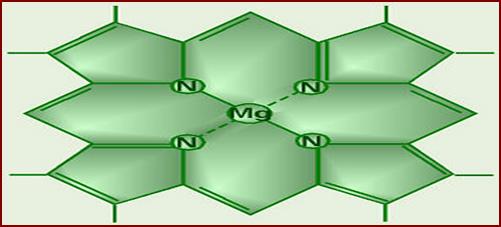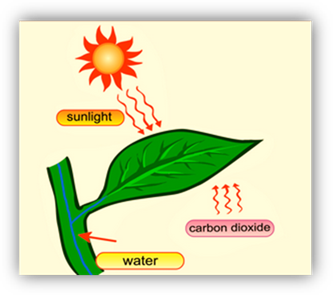
PHOTOSYNTHESIS - THE WHAT,
WHERE,
HOW, AND WHY OF IT
Unit Overview
Photosynthesis is probably
the most important chemical reaction in the world. Without it life as we know it could not
exist. In this lesson we will define it
and look at the structures where it occurs.
We will see in a simplified manner how it occurs. Then we will find out why it is so important
for us to study it.
What is
Photosynthesis?
Photosynthesis is
the process by which plants, algae, and some bacteria use the energy of light,
water, and carbon dioxide to make sugar.
The word itself can give us clues as to its definition. The prefix “photo” refers to light and the
remainder of the word “synthesis” means to make or put together. So photosynthesis is putting together with
light. Of course this is a bit of a
simplification. Research is still going
on to study this very complex process.
We will look at just the basic process.
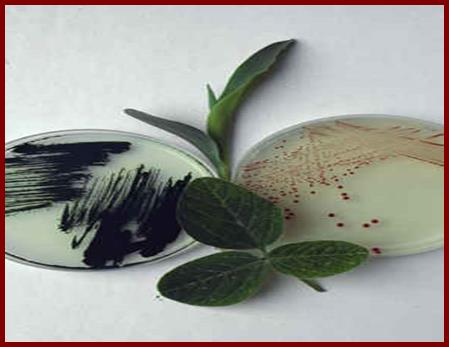
Plants and Bacteria
that Photosynthesize
Where Does Photosynthesis Take Place?
Photosynthesis
can only occur is plants, algae, and some bacteria because only those organisms
contain chlorophyll, an essential
chemical to trap the energy of light.
Since we are more familiar with plants, we will focus on where
photosynthesis occurs in plants. The
leaves of plants are the factories where photosynthesis occurs. Different parts of the leaf have different
functions or jobs to do. Examine the
diagram on the next page as the parts of the leaf are discussed. The outermost layer is the cuticle which is a
waxy coating that keeps the leaf from drying out. The upper and lower dermis layers are for
protection, just like your skin protects the tissues underneath it. The stoma is an opening on the lower surface
of the leaf that allows
gases
to move into and out of the leaf. The
guard cells open and close the stoma.
The vascular bundles are the transportation system for the liquids;
these bundles are seen as the veins in a leaf.
Water and dissolved minerals are carried into the leaf by the
xylem. Dissolved sugars and other
nutrients are carried from the leaf by the phloem. The mesophyll consists of thin-walled cells
that contain the chloroplasts, and
it is within the chloroplasts that the chlorophyll is found. The palisade mesophyll cells are closely
packed at the upper surface of the leaf and contain many chloroplasts. This is where most photosynthesis
occurs. The spongy mesophyll cells are
loosely arranged allowing for gases to circulate as they go in and out of the
stomata (plural for stoma).
Leaf Structures
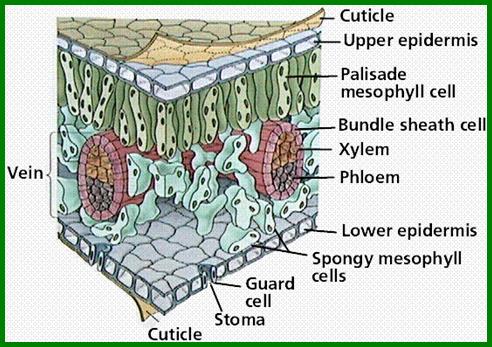
How Does Photosynthesis Occur?
The
key to the process of photosynthesis is chlorophyll. Chlorophyll is a green pigment. A pigment is any
substance that absorbs light. Light is
composed of different wavelengths, and each wavelength is seen by our eyes as a
different color. The various colors in
light are those of the rainbow - red, orange, yellow, green, blue, and violet. Different pigments absorb different
wavelengths of light and reflect the rest.
That is why we associate the word pigment with color. For example, all paints contain pigments that
give them their specific color. The
color reflected is the color of the pigment; so red paint has in it a pigment
that absorbs all light except red light and that is the light that is reflected
and seen by our eyes. White objects
reflect all light, and black objects absorb all light, reflecting none. Since chlorophyll is green, it is a pigment
that absorbs all colors except for green and yellow. The green and yellow wavelengths are
reflected. Since the epidermis of a leaf
is transparent so light can shine through it, we seen the green of the
chloroplasts which gives all leaves their green color.
The
chlorophyll molecule is arranged in a circle or ring so that electrons can flow
easily around it. In case you do not
know, electrons are tiny negative particles that buzz around the nucleus or
center of all atoms. Under certain
circumstances electrons can move from one atom to another. Some plants have additional pigments called carotenoids that can also move
electrons. The word carrot comes from
the fact that carrots contain carotenoids.
Can you guess what color carotenoids are? Yes, they are orange! Why are moving electrons so important?
The
wonder of photosynthesis is that it takes sunlight, which except for keeping us
warm cannot be used by us, and transforms it into chemical energy, which is energy stored in the molecules of a
substance. (Molecules are simply atoms
hooked together in various combinations.)
This stored chemical energy is used as food either directly or
indirectly by all living beings. Without
photosynthesis no living being would be able to able to grow or reproduce or
even exist! Chlorophyll and carotenoids
use sunlight by using the energy in light to move electrons. Carotenoids are known as accessory pigments
because they help by directing electrons toward the chlorophyll. We say that the electrons are excited because
they quickly move around the chlorophyll molecules until they reach a central
area called the reaction site where photosynthesis occurs.
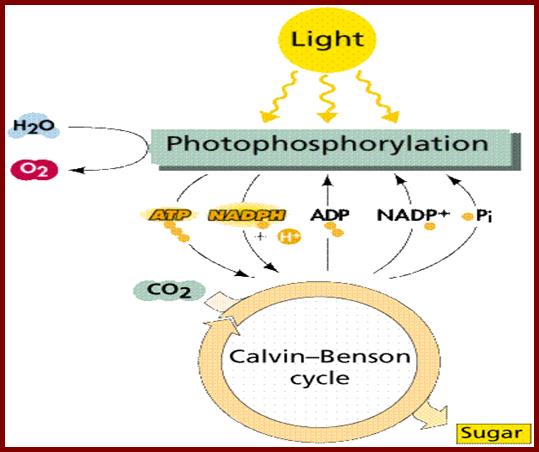
Photosynthesis
occurs in two parts: a light reaction and a dark reaction. The light
reaction as the name suggests requires direct sunlight. During this reaction the plant uses water, H
2 O, to create two types of high energy molecules that are abbreviated
ATP and NADPH. These are very complex
molecules made from other less energized molecules known as ADP and NADP+. The water is brought to the leaf from the
roots of the plant through the xylem tissues.
The energy needed for the reaction comes from those energetic little
electrons. A fancy-sounding name for
this process is photophosphorylation, but we can just remember that it is the
light reaction.
Oxygen,
O2, is also produced. This is
important because we need oxygen to breathe as do animals. Do you know that the plant itself needs
oxygen to use the food it makes during photosynthesis but that it makes a lot
more oxygen than it uses? For example,
on one sunny summer day an acre of corn produces enough oxygen for 130
people! An average-sized tree produces
enough oxygen to keep 3 people alive!
The
second reaction is known as the dark
reaction, because it can occur without sunlight directly. It uses the ADP
and NADPH made from the first reaction and carbon dioxide, CO2, to
produce a simple sugar called glucose, C6H12O6. The carbon dioxide enters from the air
through the stomata, the holes in the lower surface of the leaf. This process is known as carbon fixation
(Calvin-Benson cycle in the diagram) because it puts the carbon in a useable
form. Once glucose is made, it can be
changed in the plant into other sugars, starches, and cellulose. These are called carbohydrates and are an
important part of the food for plants and animals. In addition, proteins and fats can also be
made. Carbohydrates, proteins, and fats
are basic nutrients needed by living things.
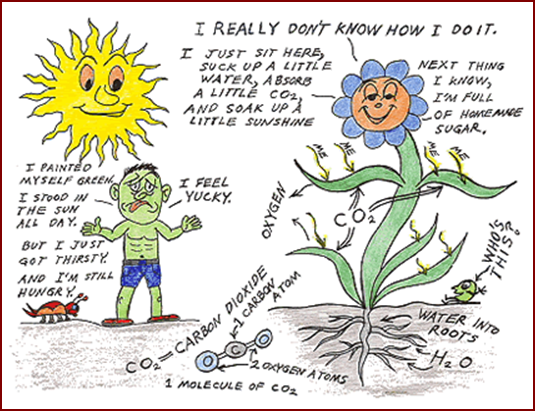
We
should be very appreciative of plants for without them we would soon run out of
oxygen and food. Another important
benefit of plants is that they use carbon dioxide during photosynthesis and
therefore, help reduce the threat of global warming caused by the build up in part of carbon
dioxide in the atmosphere. We have
studied the photosynthesis in plants but we must not forget that algae and some
bacteria also photosynthesize. Many of
these are found in the ocean as phytoplankton,
tiny organisms that can photosynthesize. The ocean covers 70% of the Earth’s
surface. Although these organisms are
tiny, they are very abundant. This makes
them a very important source of food for marine life and users of carbon
dioxide, just like the land plants.
![]() The Effects
of Global Warming on Coastal Biomes (
The Effects
of Global Warming on Coastal Biomes (
Scientists
often like to write chemical reactions in a short-hand way called a chemical
equation. The basic equation for
photosynthesis is fairly simple and can be shown as:

This
is read as six molecules of water plus six molecules of carbon dioxide produce
one molecule of glucose (a sugar) plus six molecules of oxygen. This equation combines both the light and
dark reactions into one. The actual
process of photosynthesis involves many intermediate steps and can consist of
at least 80 different reactions, but we will let the biologists and research
scientists worry about those for now. We
will stick with what is needed to get the reaction going and what is formed. Of course we dare not forget that sunlight
and chlorophyll are also essential.
Because the chlorophyll is a catalyst,
a substance that is needed for the reaction but is not used up, it is not
included in the reaction. However, we
could rewrite the reaction and put the chlorophyll above the yields sign (the
arrow) to show its importance. We could
also include the sunlight as the energy put into the reaction. Then the equation would look like this:

![]() Photosynthesis Reaction (
Photosynthesis Reaction (
Why is Photosynthesis Important?
Of course the most obvious answer
to this question is that without photosynthesis we would have no food, not only
us, but animals and plants as well.
Plants use the food they make in order to release the stored chemical
energy in the food to carry on all their life processes, such as growing and
reproducing. They do not use all the
food they make, so other organisms can use it.
For example, we can eat the corn from a corn plant. We are actually eating the seeds that the
corn plant produces during the process of reproduction. A cow might eat the corn and then later, we
may eat the cow. Either way, we benefit
from the food produced during photosynthesis.
Let’s not forget the
production of oxygen. As stated before,
the plant does use some oxygen while using part of the food it makes, but it
makes much more oxygen than it uses so animals and humans can use this
oxygen. We need oxygen for the same
reason that plants do – to release the chemical energy in the food we eat so
that we can carry on our life processes.
This process is known as respiration. It is the reverse of photosynthesis. Part of that energy is used just to keep our
bodies at about 98.6 degrees Fahrenheit.
Another important purpose
of photosynthesis is to keep the supply of carbon dioxide balanced so that global
warming can be slowed. All the large
forests in the world and the phytoplankton in the ocean are very helpful in
this regard.
But there are other
reasons. What about the clothes we
wear? If they are cotton or linen, they
are made from fibers taken from plants.
Cotton comes from the cotton plant, and linen is made from the fibers in
the flax plant. If they are wool, they
come from the hair of sheep or goats.
These animals could not survive without the energy and nutrients stored
in the plants that they eat. If the
fiber is a synthetic like nylon, Dacron, polyester, or acrylic, these are made
from petroleum and that too is made from plants.
Petroleum is also used for
fuel. Along with coal and natural gas,
it is known as a fossil fuel because
it has been formed over many, many years from the remains of dead plants that
have been subjected to extreme heat and pressure deep within the earth. So without plants we would have no fossil
fuels. That means no way to power our
automobiles or four-wheelers or motorcycles or airplanes and no way for many of
us to heat our homes. Fuel oil comes
from petroleum. Even if we burn wood, is
that not a product of trees? If your
home is heated with electricity, remember that most power plants burn coal or
oil, both fossil fuels, to produce electricity.
Another fuel that is being used more and more is ethanol. This can be derived from petroleum, but it
can also be made by fermenting corn.
Much of our gasoline has a small percentage of ethanol made from corn added
to it. This allows us to use less
petroleum so that the United States is less dependent upon foreign sources of
oil. This gasoline is sometimes called
gasohol. Industries also need fuel to
power their machines.
A fuel is a material that releases energy in the forms of heat and
light when burned. Where does this
energy come from? If it is a fossil
fuel, it was stored as chemical energy in the plant from which the fuel was
made during the process of photosynthesis.
Plants (and some bacteria and algae) are marvelous factories for
converting the energy of sunlight into chemical energy that can be stored
indefinitely. They store away sunshine
for later use. The worrisome fact is
that as we burn these fuels we are releasing energy from sunlight that was
stored over a long time period, and we are doing it quickly. Will we run out of energy? In addition, carbon dioxide and various air
pollutants, like nitrogen oxides, are also being released.
If
that is not enough reason to value plants for carrying on photosynthesis, let’s
take a look at the buildings around us.
Many parts of these buildings come directly or indirectly from
plants. If you live in a house made of
lumber that is a direct product from trees.
What about building materials inside your house? Plastics, paints, some flooring, and sealants
are made from petroleum or coal. Your
roof may have asphalt shingles on it, another product of petroleum. The carpets in your house are made from
fibers like your clothing. Are you
beginning to be thankful for plants?
What’s in a Barrel of Oil?
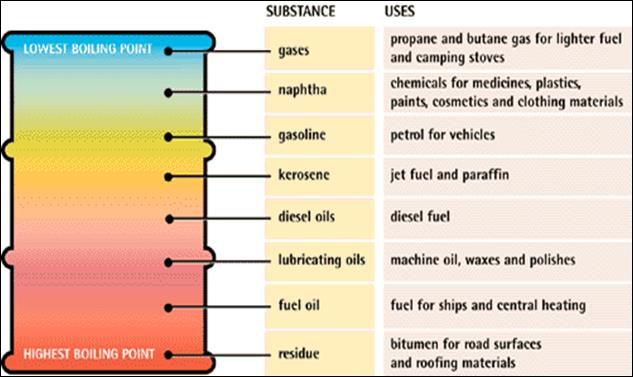
Some of the many products we get from petroleum.
There are other reasons to
be thankful for photosynthesis. Today
scientists are unlocking more and more secrets about how it occurs. Remember it is a very complex process. Perhaps through this knowledge scientists can
develop plants that trap the energy of light more efficiently and produce a
greater yield of crops to feed the world’s growing population. Most plants are not very efficient at doing
this. For example, a corn field traps
only about 1% to 2% of the sunshine during photosynthesis. Sugar cane is more efficient at about 8%, but
uncultivated plants that you might find along the roadside, for example, trap a
mere .2% of the sunlight. Another reason
that photosynthesis is not very efficient is that on very hot days,
photosynthesis can stop or slow down.
That is because not only does carbon dioxide enter the plant through
stomata, but water as water vapor leaves the plant through these openings. This process is known as transpiration To keep the plant from loosing too much water and
thus wilting, the stomata close if the temperature soars. No more carbon dioxide can enter, so
photosynthesis slows or stops altogether.
Knowing more about photosynthesis can help us
improve our environment. New herbicides,
materials that kill plants, could be developed that work on only certain plants
by interfering with their photosynthesis because the way photosynthesis occurs
in plants can be slightly different.
These herbicides would not be hazardous to the rest of the
environment. Learning more about
photosynthesis may even help us develop smaller and faster computers. Remember that the process involves moving
electrons and that is what electronics is all about. Even diseases like skin cancer may be easier
to treat if we understand more about photosynthesis. Perhaps we can use this knowledge to design
better solar collectors. One scientist
is working on placing films on roofing shingles that will absorb different
wavelengths of light and then convert that light to electricity. This should be more efficient than our
present day collectors and perhaps cheaper, too. Uncovering the mysteries that still exist
about photosynthesis can lead to great things.
Bioremediation is any process
using microorganisms to return a polluted environment back to its original
state. We can use bacteria in the
presence of light to remove toxins from water.
Oil spills are often bio remediated by adding fertilizer to stimulate the
bacteria to decompose the oil molecules.
Fun Facts Related to Photosynthesis
Why do some plants stay
green even during the hottest, driest periods in summer and others wither or
turn brown? While many plants shut down
photosynthesis when their stomata close, some like crabgrass, corn, and sugar
cane can use very low levels of carbon dioxide and stay green by continuing to
perform photosynthesis.
How can desert plants
photosynthesize in such heat? Many
desert plants close their stomata during the day to conserve water, but open
them at night. During the night, the
carbon dioxide enters the plant and is stored in a chemical reaction that
releases it during the day so that photosynthesis can occur.
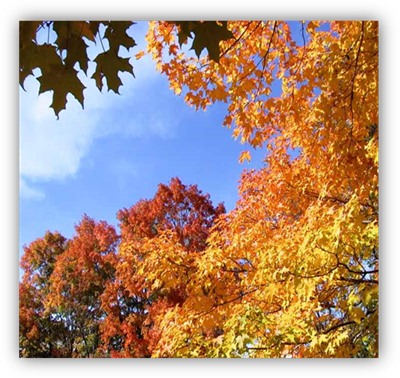
Why do leaves change color in the fall? We have already said that it is the presence
of chlorophyll that gives leaves their green color. When the amount of light begins to lessen
during the autumn months, chlorophyll in the leaves begins to break down. Then the yellows and orange pigments that
were in the leaves all along begin to show up.
They had been masked by the green of the chlorophyll during spring and
summer. The reds and purples are a
result of glucose being trapped in the leaves.
The bright sunlight and cool nights of autumn cause the glucose to
change into other chemicals that give off these colors. Some leaves like oaks are brown. This is due to waste materials in the
leaves. Many oaks also keep their leaves
for most of the winter.
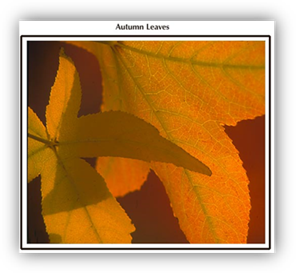
What
causes the reds and yellows in these leaves? Is it the same reason for both?
 Now answer questions 1 through 25.
Now answer questions 1 through 25.
